初中英语9种基本时态
英语中的16种时态

英语中的16种时态英语时态分为16种,下面就为大家一一列举:1、一般现在时态:表示现在的状态,或者经常反复发生的动作或习惯。
例如:I am a student.我是一名学生。
2、现在进行时态:表示正在进行的动作或存在的状态。
例如:He is studying.他在学习。
3、现在完成时态:表示过去发生的动作对现在造成的影响或结果。
例如:I have finished my homework.我已经完成了我的作业。
4、现在完成进行时态:表示从过去开始一直持续到现在的动作或状态。
例如:We have been waiting for you for hours.我们已经等了你几个小时了。
5、过去一般时态:表示过去某个时间点的状态或动作。
例如:He wasa teacher.他是一名老师。
6、过去进行时态:表示过去某个时间点正在进行的动作或存在的状态。
例如:They were playing football at that time.他们在那个时候正在踢足球。
7、过去完成时态:表示过去的过去,即过去某一时间之前发生的动作或状态。
例如:They had finished their work before we arrived.在我们到达之前,他们已经完成了他们的工作。
8、过去完成进行时态:表示过去某一时间之前一直在进行的动作或状态。
例如:We had been waiting for the bus for hours before it finally arrived.在公共汽车最终到达之前,我们已经等了好几个小时。
9、将来一般时态:表示将来某个时间点的状态或动作。
例如:She will be a doctor.她将成为一名医生。
10、将来进行时态:表示将来某个时间点正在进行的动作或存在的状态。
例如:We will be studying in the library tomorrow afternoon.我们明天下午将在图书馆学习。
初中所有英语时态
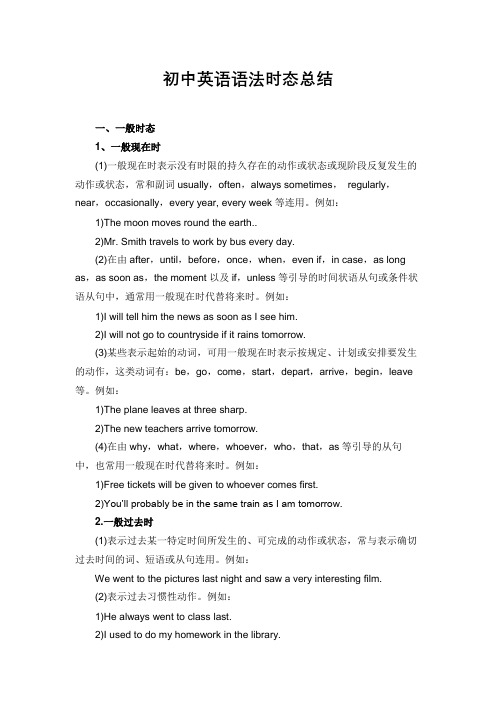
初中英语语法时态总结一、一般时态1、一般现在时(1)一般现在时表示没有时限的持久存在的动作或状态或现阶段反复发生的动作或状态,常和副词usually,often,always sometimes,regularly,near,occasionally,every year, every week等连用。
例如:1)The moon moves round the earth..2)Mr. Smith travels to work by bus every day.(2)在由after,until,before,once,when,even if,in case,as long as,as soon as,the moment以及if,unless等引导的时间状语从句或条件状语从句中,通常用一般现在时代替将来时。
例如:1)I will tell him the news as soon as I see him.2)I will not go to countryside if it rains tomorrow.(3)某些表示起始的动词,可用一般现在时表示按规定、计划或安排要发生的动作,这类动词有:be,go,come,start,depart,arrive,begin,leave 等。
例如:1)The plane leaves at three sharp.2)The new teachers arrive tomorrow.(4)在由why,what,where,whoever,who,that,as等引导的从句中,也常用一般现在时代替将来时。
例如:1)Free tickets will be given to whoever comes first.2)You’ll probably be in the same train as I am tomorrow.2.一般过去时(1)表示过去某一特定时间所发生的、可完成的动作或状态,常与表示确切过去时间的词、短语或从句连用。
初中英语八种时态归纳总结

初中英语八种时态归纳总结Newly compiled on November 23, 2020初中英语八种时态归纳总结时态是英语学习中一个至关重要的内容,初中学生在实际运用时,往往对时态总是倍感棘手,下面我们就归纳一下这几种时态。
一、一般现在时:概念:经常、反复发生的动作或行为及现在的某种状况。
时间状语:always, usually, often, sometimes, every week (day, year, month…), once a week, on Sundays, etc.基本结构:①主语 + be动词 + 其他;②主语 + 行为动词 + 其他否定形式:①主语 + am/is/are + not + 其他;②此时态的谓语动词若为行为动词,则在其前加don't,主语为第三人称单数,则用doesn't,同时还原行为动词。
一般疑问句:①把be动词放于句首;②用助动词do提问,如主语为第三人称单数,则用does,同时还原行为动词。
二、一般过去时:概念:过去某个时间里发生的动作或状态;过去习惯性、经常性的动作、行为。
时间状语:ago, yesterday, the day before yesterday, last week(year, night, month…), in 1989, just now, at the age of 5, one day, long long ago, once upon a time, etc.基本结构:①主语 + be动词 + 其他;②主语 + 行为动词 + 其他否定形式:①主语 + was/were + not + 其他;②在行为动词前加didn't,同时还原行为动词。
一般疑问句:①was或were放于句首;②用助动词do的过去式did 提问,同时还原行为动词。
三、现在进行时:概念:表示现阶段或说话时正在进行的动作及行为。
初中英语八种时态

初中英语八种时态初中英语中,通常会学习到八种时态:1. 现在简单时态 (Present Simple)- 表示经常性或普遍性的行为、习惯、真理等。
- 例句:I play soccer every weekend.(我每个周末踢足球)2. 过去简单时态 (Past Simple)- 表示过去某个时间发生的动作或状态,常与过去的时间副词连用。
- 例句:Last night, I watched a movie.(昨晚,我看了一部电影)3. 将来简单时态 (Future Simple)- 表示将来发生的动作或状态。
- 例句:I will go to the beach tomorrow.(明天我会去海滩)4. 现在进行时态 (Present Continuous)- 表示现在正在进行的动作。
- 例句:She is studying for her exam.(她正在为考试学习)5. 过去进行时态 (Past Continuous)- 表示过去某个时间正在进行的动作。
- 例句:They were playing basketball when it started raining.(下雨时,他们正在打篮球)6. 将来进行时态 (Future Continuous)- 表示将来某个时间正在进行的动作。
- 例句:This time tomorrow, I will be flying to Paris.(明天这个时候,我将会在飞往巴黎的路上)7. 现在完成时态 (Present Perfect)- 表示过去发生的动作或经历的经验与现在的关系。
- 例句:I have visited Japan twice.(我去过日本两次)8. 过去完成时态 (Past Perfect)- 表示过去某个时间或动作之前已经发生的动作。
- 例句:She had finished her homework before I arrived.(我到之前,她已经完成作业了)这是初中英语中常用的八种时态。
初中英语时态一般现在时 现在进行时 一般过去时 过去进行时

一般现在时1. 一般现在时的基本用法:1) 经常性或习惯性的动作,常与表示频率副词的时间状语连用。
时间状语:every morning(afternoon, Sunday), sometimes, on Sunday, often, usually等.例如:I wake up at six O’clock every morning.My friends often go to the park on Sundays.2) 用于表示客观真理,客观存在,科学事实。
例如:The earth moves around the sun.Tomorrow is Tuesday.3) 用于格言或警句中。
例如:Where there is a will, there is a way.4) 用于表示现在时刻的状态、能力、性格、个性。
例如:I don't want so much.She is a good girl and always help others.My watch is very new。
2. 一般现在时的构成:当主语是第一人称,第二人称或第三人称复数时,谓语动词要用动词原形。
当主语是第三人称单数时,谓语动词要用第三人称单数形式,即动词词尾要加s或es. 例. We have four classes in the morning every day.They work in a big office.She likes singing very much.附注:动词的第三人称单数变化形式分为规则变化和不规则变化两种形式。
1. 规则变化:(1)直接在动词词尾加-s.ask---asks work---works get---gets stay---stays(2)以字母s, x, ch, sh或o结尾的动词,在词尾直接加-es.fix---fixes do---does go---goes pass---passeswatch---watches wash____washes(3)以“辅音字母加“y”结尾的动词,要先变y为i再加-es.try---tries study---studies cry---cries2.不规则变化:be---- is have----has3. 一般现在时的句子转换:变否定句、一般疑问句(1)一般疑问句:当句子中有be动词或情态动词时,则把be动词或情态动词提到主语的前面变成疑问句;否定句:在be动词或情态动词后面加not变成否定句.例:She is a student. I can swim.→Is she a student? →Can you swim?→She is not a student. →I can not swim.(2)一般疑问句:当句子中即没有be动词,也没有情态动词时,则在主语前加助动词do, does 变成问句;否定句:在主语后谓语动词前加助动词don’t, doesn’t变成否定句,助动词后的谓语动词要变成动词原形。
初中动词的时态与语态
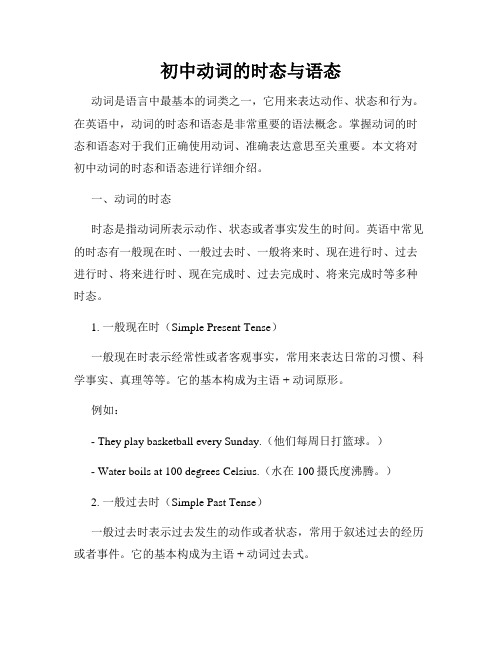
初中动词的时态与语态动词是语言中最基本的词类之一,它用来表达动作、状态和行为。
在英语中,动词的时态和语态是非常重要的语法概念。
掌握动词的时态和语态对于我们正确使用动词、准确表达意思至关重要。
本文将对初中动词的时态和语态进行详细介绍。
一、动词的时态时态是指动词所表示动作、状态或者事实发生的时间。
英语中常见的时态有一般现在时、一般过去时、一般将来时、现在进行时、过去进行时、将来进行时、现在完成时、过去完成时、将来完成时等多种时态。
1. 一般现在时(Simple Present Tense)一般现在时表示经常性或者客观事实,常用来表达日常的习惯、科学事实、真理等等。
它的基本构成为主语 + 动词原形。
例如:- They play basketball every Sunday.(他们每周日打篮球。
)- Water boils at 100 degrees Celsius.(水在100摄氏度沸腾。
)2. 一般过去时(Simple Past Tense)一般过去时表示过去发生的动作或者状态,常用于叙述过去的经历或者事件。
它的基本构成为主语 + 动词过去式。
例如:- I visited my grandparents last weekend.(我上个周末去看望了我的祖父母。
)- She didn't go to school yesterday.(她昨天没有去上学。
)3. 一般将来时(Simple Future Tense)一般将来时表示将来要发生的动作或者状态,常用于表达计划、打算、预测等等。
它的基本构成为主语 + will + 动词原形。
例如:- We will have a party next Friday.(我们下周五要举办一个聚会。
)- She won't come to the meeting tomorrow.(她明天不会来参加会议。
)4. 现在进行时(Present Continuous Tense)现在进行时表示正在进行的动作,通常用于描述当前正在发生的事情。
初中英语基础语法必会八种基本时态

初中英语基础语法必会八种基本时态1. 一般现在时概念:表示经常发生的动作或经常存在的状态。
常和always,often,usually,sometimes,every day等表时间的状语连用。
如:1)I go to school every day . 我每天都去学校。
(表经常)2)He is always like that . 他总是那样。
(表状态)构成:1)主语+ be (am / are / is )+……2)主语+ 实义动词/三单动词+…2.一般过去时概念:1)表示过去某个时间发生的动作或存在的状态。
常和表示过去的时间状语连用. 如:yesterday,last week,in 1998,two days ago等。
如:I went to a movie yesterday. 我昨天去看了一场电影。
2)也可表示过去经常或反复发生的动作。
如:He always went to work by bike last week.构成:1)主语+ be (was / were)+……2)主语+实义动词过去式3. 现在进行时概念:表示现在(说话瞬间)正在进行或发生的动作。
如:He is singing.They are watching TV now.构成:主语+助动词be(am/are/is)+动词-ing形式构成。
4. 过去进行时概念:表示过去某一时刻或某一段时间正在进行的动作. 这一特定的过去时间除了有上下文暗示外,一般用时间状语来表示。
如:1)——What were you doing?——I was jumping.2)——What was the boy doing when the UFO arrived?——He was sleeping.构成:主语+助动词be(was/were)+动词-ing形式构成。
5. 一般将来时概念:表示将来某个时间要发生的动作或存在的状态,也表示将来经常或反复发生的动作,常与表示将来的时间状语连用,如:tomorrow,next week,next year,in the future等.如:He will go shopping tomorrow.They are going to play basketball next week.构成:1)主语+助动词will +动原+…2)主语+ be going to +动原+….6. 过去将来时概念:表示在过去将来的某一时间发生的动作或存在的状态。
初中英语9大时态+6大词性+3大从句+70个句型
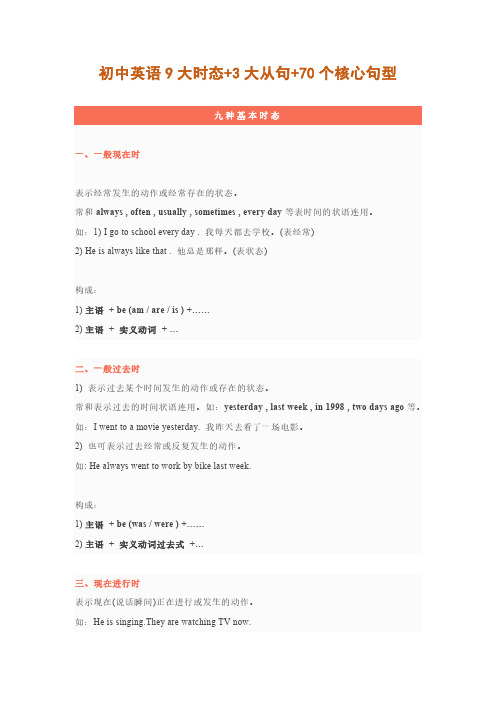
初中英语9大时态+3大从句+70个核心句型九种基本时态一、一般现在时表示经常发生的动作或经常存在的状态。
常和always , often , usually , sometimes , every day等表时间的状语连用。
如:1) I go to school every day . 我每天都去学校。
(表经常)2) He is always like that . 他总是那样。
(表状态)构成:1) 主语+ be (am / are / is ) +……2) 主语+ 实义动词+ …二、一般过去时1) 表示过去某个时间发生的动作或存在的状态。
常和表示过去的时间状语连用。
如:yesterday , last week , in 1998 , two days ago等。
如:I went to a movie yesterday. 我昨天去看了一场电影。
2) 也可表示过去经常或反复发生的动作。
如: He always went to work by bike last week.构成:1) 主语+ be (was / were ) +……2) 主语+ 实义动词过去式+…三、现在进行时表示现在(说话瞬间)正在进行或发生的动作。
如:He is singing.They are watching TV now.构成:主语+ 助动词be(am/are/is) + 动词-ing形式构成四、过去进行时表示过去某一时刻或某一段时间正在进行的动作。
这一特定的过去时间除了有上下文暗示外,一般用时间状语来表示。
如:1) ---What were you doing?---I was jumping.2) ---What was the boy doing when the UFO arrived?---He was sleeping.构成:主语+ 助动词be(was/were) + 动词-ing形式构成.五、一般将来时表示将来某个时间要发生的动作或存在的状态,也表示将来经常或反复发生的动作。
初中英语语法八大时态总结(完整版)
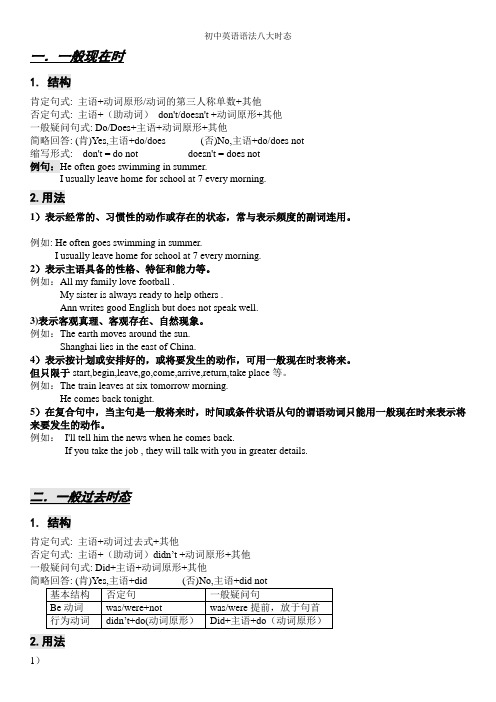
初中英语语法八大时态一.一般现在时1.结构肯定句式: 主语+动词原形/动词的第三人称单数+其他否定句式: 主语+(助动词)don't/doesn't +动词原形+其他一般疑问句式: Do/Does+主语+动词原形+其他简略回答: (肯)Yes,主语+do/does (否)No,主语+do/does not缩写形式: don't = do not doesn't = does not例句:He often goes swimming in summer.I usually leave home for school at 7 every morning.2.用法1)表示经常的、习惯性的动作或存在的状态,常与表示频度的副词连用。
例如: He often goes swimming in summer.I usually leave home for school at 7 every morning.2)表示主语具备的性格、特征和能力等。
例如:All my family love football .My sister is always ready to help others .Ann writes good English but does not speak well.3)表示客观真理、客观存在、自然现象。
例如:The earth moves around the sun.Shanghai lies in the east of China.4)表示按计划或安排好的,或将要发生的动作,可用一般现在时表将来。
但只限于start,begin,leave,go,come,arrive,return,take place等。
例如:The train leaves at six tomorrow morning.He comes back tonight.5)在复合句中,当主句是一般将来时,时间或条件状语从句的谓语动词只能用一般现在时来表示将来要发生的动作。
初中英语八种基本时态总结
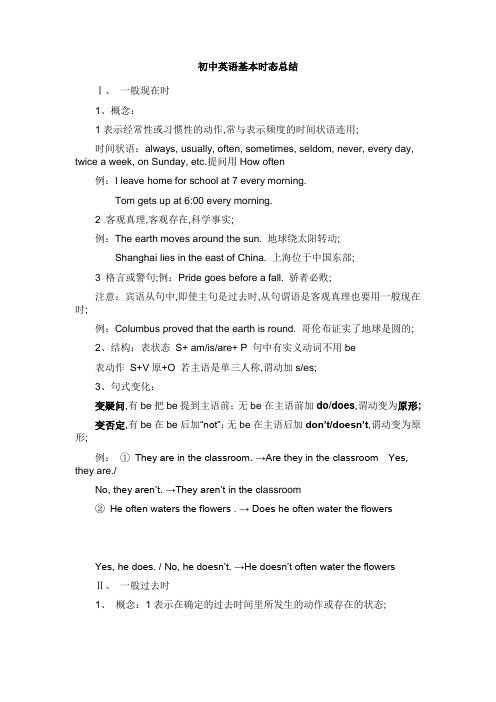
初中英语基本时态总结Ⅰ、一般现在时1、概念:1表示经常性或习惯性的动作,常与表示频度的时间状语连用;时间状语:always, usually, often, sometimes, seldom, never, every day, twice a week, on Sunday, etc.提问用How often例:I leave home for school at 7 every morning.Tom gets up at 6:00 every morning.2 客观真理,客观存在,科学事实;例:The earth moves around the sun. 地球绕太阳转动;Shanghai lies in the east of China. 上海位于中国东部;3 格言或警句;例:Pride goes before a fall. 骄者必败;注意:宾语从句中,即使主句是过去时,从句谓语是客观真理也要用一般现在时;例:Columbus proved that the earth is round. 哥伦布证实了地球是圆的;2、结构:表状态S+ am/is/are+ P 句中有实义动词不用be表动作S+V原+O 若主语是单三人称,谓动加s/es;3、句式变化:变疑问,有be把be提到主语前;无be在主语前加do/does,谓动变为原形;变否定,有be在be后加“not”;无be在主语后加don’t/doesn’t,谓动变为原形;例:①They are in the classroom. →Are they in the classroom Yes, they are./No, they aren’t. →They aren’t in the cl assroom②He often waters the flowers . → Does he often water the flowersYes, he does. / No, he doesn’t. →He doesn’t often water the flowersⅡ、一般过去时1、概念:1表示在确定的过去时间里所发生的动作或存在的状态;常用时间状语:yesterday, the day before yesterday, last week, just now, an hour ago, the other day, in 1982. at the age of 5, one day, long long ago, etc.例:Where did you go just now2表示在过去一段时间内,经常性或习惯性的动作;例:When I was a child, I often played football in the street.2、结构:表状态S+ was/were+ P表动作S+V过去式+O 注:句中有实义动词不用be3、句式变化:变疑问,有be把be提到主语前;无be在主语前加did,谓动变为原形;变否定,有be在be后直接加“not”;无be在主语后加didn’t,谓动变为原形.例:①She was in Xi’an last month. → Was she in Xi’an last monthYes, she was. /No, she wasn’t. →She wasn’t in Xi’an last month.②Danny grew a rose just now, → Did Danny grow a rose just nowYes, he did. / No, he didn’t. →Danny didn’t grow a rose just now,Ⅲ、现在进行时:1. 概念:表示现阶段或说话时正在进行的动作;时间状语:now, at this time, these days,以及有look, listen时;例:ListenThe birds are singing.2、结构:S + am/is/are + doing助动现在分词3、句式变化:变疑问,把am/is/are提到主语前;变否定,在am/is/are后直接加“not”;例:①I am writing a letter now. → Are you writing a letter nowYes, I am. /No, I’m not. →I am not writing a letter now. 注:am和not不能缩写;②The boys are playing football. → Are the boys playing footballYes, they are. / No, they aren’t. →The boys aren’t playing football.Ⅳ、过去进行时:1. 概念:表示过去某段时间或某一时刻正在发生或进行的动作;.时间状语:at this time yesterday, at that time,at 8:00 yesterday,或有when / while引导的时间状语从句等;例:We were having an English class at 9:30 yesterday morning.I was reading a book while my mother was watching TV.2、结构:S + was/were + doing3、句式变化:变疑问,把was/were提到主语前;变否定,在was/were后直接加“not”;例:①At that time they were working in the garden. → Were they working inthe garden at that timeYes, they were. / No, they weren’t.→At that time they were working in the garden.②When he came in, I was reading a newspaper. →When he came in, were you reading a newspaperYes, I was. / No, I wasn’t.→When he came in, I wasn’t reading a newspaper.Ⅴ、一般将来时1. 概念:表示将要发生的动作或存在的状态;时间词:tomorrow, tomorrow morning, at seven o'clock tomorrow evening, next year, this year, at the end of this term, from now,in ten minutes, in 2025例:They will do an experiment tomorrow afternoon.Brian is going to draw twenty pictures at the end of this term.2、结构:S +will+ V原+其他will 可改为be going to ,当主语是第一人称时will可用shall例:Which paragraph shall I read first 我先读哪一段呢Will you/Are you going tobe at home at seven this evening3、句式变化:变疑问,把will提到主语前;变否定,在will后直接加“not”;例; She will drive to Beijing next week. → Will she drive to Beijing next weekYes, she will. / No, she won’t. →She won’t drive to Beijing next week.★be going to + V原表示a. 主语的意图,即将做某事;例:What are you going to do tomorrowb. 计划,安排要发生的事;例:The play is going to be produced next month;c. 有迹象要发生的事;例:Look at the dark clouds, there is going to be a storm.★be +不定式:表示将来,按计划或正式安排将发生的事;例:We are to discuss the report next Saturday. 我们下星期六将讨论这份报告★用现在进行时表示将来come, go, arrive, leave, start, begin, return等终止性动词可用现在进行时表示将来;例:I'm leaving tomorrow. 明天我要走了;Are you staying here till next week 你会在这儿呆到下周吗Ⅶ、现在完成时:1. 表示:①过去发生或已经完成的动作对现在造成的影响或结果;时间词:ever, never, already, yet, before, just, recently/ lately最近, in the past few years2. ②或从过去已经开始持续到现在的动作或状态; 时间词:for + 时间段,since +过去时间点/从句;提问用How long例:The countryside has changed a lot in the past few years.He has learned French for two years.2.结构:S + have/has + done助动过去分词3. 句式变化:变疑问,把have/has提到主语前;变否定,在have/has后直接加“not”;例:①I've already written an article. → Have you written an article yet Yes, I h ave. / No, I haven’t. →I haven’t written an article yet.②Li Ming has lived in Shijiazhuang since 1993.→ Has Li Ming lived in Shijiazhuang since 1993 Yes, he has. / No, he hasn’t.→Li Ming hasn’t lived in Shijiazhuang since 1993.★比较一般过去时与现在完成时1一般过去时表示过去某具体时间发生的动作或单纯叙述过去的事情,强调动作;现在完成时则强调过去发生的动作对现在的造成影响,强调的是结果;2一般过去时常与具体的时间状语连用,而现在完成时通常与模糊的时间状语连用,或无时间状语;例:I saw this film yesterday. 强调看的动作发生过了I have seen this film. 强调对现在的影响,电影的内容已经知道了Why did you get up so early 强调起床的动作已发生过了Who hasn't handed in his paper 强调有卷子未交,指结果He joined the League three years ago. 强调加入这一动作He has been a League member for three years. 是团员的状态可持续句子中如有过去时的时间副词如yesterday, last, week, in 1960时,不能使用现在完成时,要用过去时;错Tom has written a letter to his parents last night.对Tom wrote a letter to his parents last night.。
初中英语中考必会时态归纳(共16种)
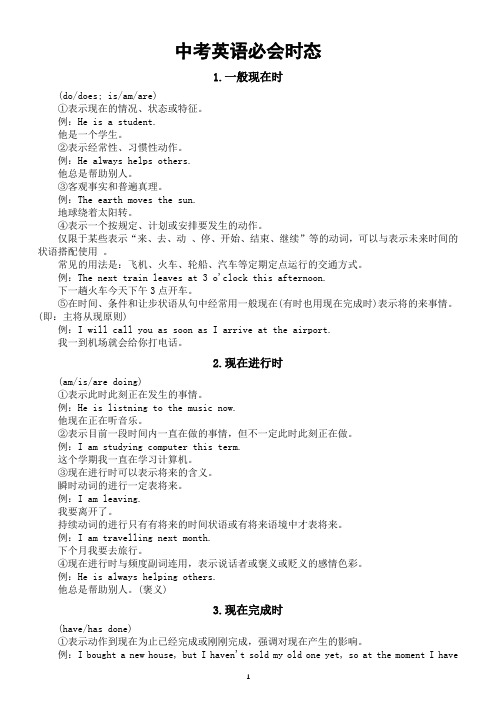
中考英语必会时态1.一般现在时(do/does; is/am/are)①表示现在的情况、状态或特征。
例:He is a student.他是一个学生。
②表示经常性、习惯性动作。
例:He always helps others.他总是帮助别人。
③客观事实和普遍真理。
例:The earth moves the sun.地球绕着太阳转。
④表示一个按规定、计划或安排要发生的动作。
仅限于某些表示“来、去、动、停、开始、结束、继续”等的动词,可以与表示未来时间的状语搭配使用。
常见的用法是:飞机、火车、轮船、汽车等定期定点运行的交通方式。
例:The next train leaves at 3 o'clock this afternoon.下一趟火车今天下午3点开车。
⑤在时间、条件和让步状语从句中经常用一般现在(有时也用现在完成时)表示将的来事情。
(即:主将从现原则)例:I will call you as soon as I arrive at the airport.我一到机场就会给你打电话。
2.现在进行时(am/is/are doing)①表示此时此刻正在发生的事情。
例:He is listning to the music now.他现在正在听音乐。
②表示目前一段时间内一直在做的事情,但不一定此时此刻正在做。
例:I am studying computer this term.这个学期我一直在学习计算机。
③现在进行时可以表示将来的含义。
瞬时动词的进行一定表将来。
例:I am leaving.我要离开了。
持续动词的进行只有有将来的时间状语或有将来语境中才表将来。
例:I am travelling next month.下个月我要去旅行。
④现在进行时与频度副词连用,表示说话者或褒义或贬义的感情色彩。
例:He is always helping others.他总是帮助别人。
(褒义)3.现在完成时(have/has done)①表示动作到现在为止已经完成或刚刚完成,强调对现在产生的影响。
初中英语必考八大时态结构及用法详解
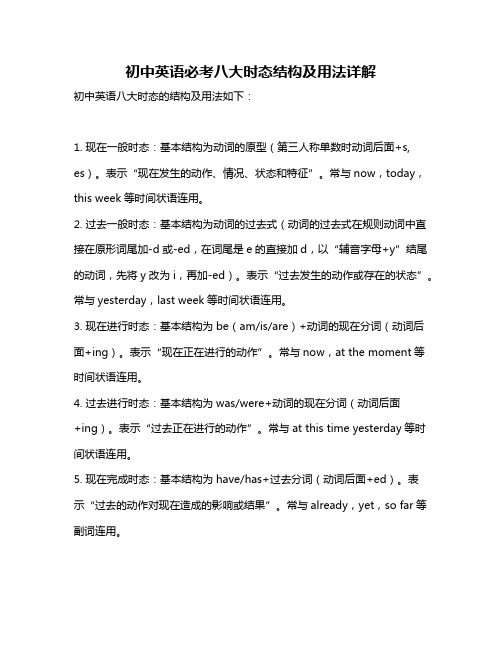
初中英语必考八大时态结构及用法详解初中英语八大时态的结构及用法如下:1. 现在一般时态:基本结构为动词的原型(第三人称单数时动词后面+s, es)。
表示“现在发生的动作、情况、状态和特征”。
常与now,today,this week等时间状语连用。
2. 过去一般时态:基本结构为动词的过去式(动词的过去式在规则动词中直接在原形词尾加-d或-ed,在词尾是e的直接加d,以“辅音字母+y”结尾的动词,先将y改为i,再加-ed)。
表示“过去发生的动作或存在的状态”。
常与yesterday,last week等时间状语连用。
3. 现在进行时态:基本结构为be(am/is/are)+动词的现在分词(动词后面+ing)。
表示“现在正在进行的动作”。
常与now,at the moment等时间状语连用。
4. 过去进行时态:基本结构为was/were+动词的现在分词(动词后面+ing)。
表示“过去正在进行的动作”。
常与at this time yesterday等时间状语连用。
5. 现在完成时态:基本结构为have/has+过去分词(动词后面+ed)。
表示“过去的动作对现在造成的影响或结果”。
常与already,yet,so far等副词连用。
6. 过去完成时态:基本结构为had+过去分词(动词后面+ed)。
表示“过去的动作在过去的某个时间之前已经完成或发生的动作或存在的状态”。
常与by the end of last year,by the time of等时间状语连用。
7. 现在完成进行时态:基本结构为have/has been+动词的现在分词(动词后面+ing)。
表示“动作从过去某时开始,一直延续到现在,或者刚刚完成”。
常与for several days,since等时间状语连用。
8. 过去完成进行时态:基本结构为had been+动词的现在分词(动词后面+ing)。
表示“过去的某个动作从过去某时开始,一直延续到过去的某个时间,或者刚刚完成”。
英语初中九大时态总结归纳

英语初中九大时态总结归纳一、一般现在时态 (Simple Present Tense)1. 基本结构:主语 + 动词原形/第三人称单数形式 + 其他2. 表达的是经常性、习惯性,以及客观真理等。
3. 一般现在时态的肯定、否定和疑问句的形式及其规则。
二、一般过去时态 (Simple Past Tense)1. 基本结构:主语 + 动词过去式/第二形式 + 其他2. 表达的是过去发生的动作、习惯或经验等。
3. 一般过去时态的肯定、否定和疑问句的形式及其规则。
三、一般将来时态 (Simple Future Tense)1. 基本结构:主语 + will + 动词原形 + 其他2. 表达的是将来发生的动作、打算、计划或预测等。
3. 一般将来时态的肯定、否定和疑问句的形式及其规则。
四、现在进行时态 (Present Continuous Tense)1. 基本结构:主语 + am/is/are + 动词ing形式 + 其他2. 表达的是现在正在进行的动作或临时状态。
3. 现在进行时态的肯定、否定和疑问句的形式及其规则。
五、过去进行时态 (Past Continuous Tense)1. 基本结构:主语 + was/were + 动词ing形式 + 其他2. 表达的是过去某一时刻正在进行的动作。
3. 过去进行时态的肯定、否定和疑问句的形式及其规则。
六、将来进行时态 (Future Continuous Tense)1. 基本结构:主语 + will be + 动词ing形式 + 其他2. 表达的是将来某一时刻正在进行的动作。
3. 将来进行时态的肯定、否定和疑问句的形式及其规则。
七、现在完成时态 (Present Perfect Tense)1. 基本结构:主语 + have/has + 过去分词 + 其他2. 表达的是过去发生但与现在有关的动作、经历或经验等。
3. 现在完成时态的肯定、否定和疑问句的形式及其规则。
初中英语八种时态总结归纳

初中英语八种时态总结归纳一、一般现在时:概念:经常、反复发生的动作或行为及现在的某种状况。
时间状语:often,usually,always,sometimes,every week(day,year,month...),once a week,on sundays,etc.基本结构:①be动词;②行为动词否定形式:①am /is /are +not;②此时态的谓语动词若为行为动词,则在其前加don't,如主语为第三人称单数,则用doesn't,同时还原行为动词。
二、一般过去时:概念:过去某个时间里发生的动作或状态;过去习惯性、经常性的动作、行为。
时间状语:ago,yesterday,the day before yesterday,last week(year,night,month...),in 1989,just now,at the age of 5,one day,long long ago,once upon a time,etc.基本结构:①be动词;②行为动词否定形式:①was/were +not;②在行为动词前加didn't,同时还原行为动词。
三、现在进行时:概念:表示现阶段或说话时正在进行的动作及行为。
时间状语:now,at this time,these days,etc.基本结构:am/is/are +doing否定形式:am/is/are +not+doing四、过去进行时:概念:表示过去某段时间或某一时刻正在发生或进行的行为或动作。
时间状语:at this time yesterday,at that time或以when引导的谓语动词是一般过去时的时间状语等。
基本结构:was/were +doing否定形式:was/were +not+doing五、现在完成时:概念:过去发生或已经完成的动作对现在造成的影响或结果,或从过去已经开始,持续到现在的动作或状态。
初中英语教研例题时态(3篇)

第1篇一、引言时态是英语语法中的重要组成部分,对于提高学生的英语水平具有重要意义。
在初中英语教学中,时态教学是基础也是难点。
为了提高初中英语教学质量,本文将从时态的概念、分类、用法及教学策略等方面进行探讨,并结合具体例题进行讲解。
二、时态的概念时态是表示动作或状态发生的时间,包括过去、现在和将来三种基本时态。
每种时态又分为一般、进行、完成和完成进行四种形式。
以下是对每种时态的简要介绍:1. 一般现在时:表示经常性、习惯性动作或状态,以及客观事实、普遍真理等。
2. 一般过去时:表示过去某个时间发生的动作或状态。
3. 一般将来时:表示将来某个时间将要发生的动作或状态。
4. 现在进行时:表示正在进行的动作或状态。
5. 过去进行时:表示过去某个时间正在进行的动作或状态。
6. 将来进行时:表示将来某个时间将要进行的动作或状态。
7. 现在完成时:表示过去发生的动作或状态对现在造成的影响或结果。
8. 过去完成时:表示过去某个时间之前已经完成的动作或状态。
9. 将来完成时:表示将来某个时间之前已经完成的动作或状态。
10. 完成进行时:表示从过去某个时间开始一直持续到现在的动作或状态。
三、时态的用法1. 一般现在时:主语为第三人称单数时,动词要用第三人称单数形式;主语为第一、二人称复数时,动词要用复数形式。
2. 一般过去时:主语为第一、二人称复数时,动词要用复数形式;主语为第三人称单数时,动词要用过去式。
3. 一般将来时:主语为第一、二人称复数时,动词要用复数形式;主语为第三人称单数时,动词要用一般将来时。
4. 现在进行时:主语为第一、二人称复数时,动词要用复数形式;主语为第三人称单数时,动词要用现在进行时。
5. 过去进行时:主语为第一、二人称复数时,动词要用复数形式;主语为第三人称单数时,动词要用过去进行时。
6. 将来进行时:主语为第一、二人称复数时,动词要用复数形式;主语为第三人称单数时,动词要用将来进行时。
初中英语九种时态归纳复习
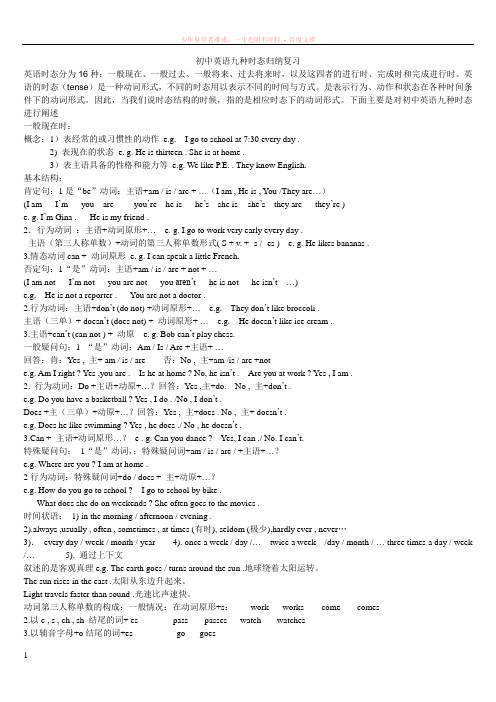
初中英语九种时态归纳复习英语时态分为16种:一般现在、一般过去、一般将来、过去将来时,以及这四者的进行时、完成时和完成进行时。
英语的时态(tense)是一种动词形式,不同的时态用以表示不同的时间与方式。
是表示行为、动作和状态在各种时间条件下的动词形式。
因此,当我们说时态结构的时候,指的是相应时态下的动词形式。
下面主要是对初中英语九种时态进行阐述一般现在时:概念:1)表经常的或习惯性的动作 e.g. I go to school at 7:30 every day .2) 表现在的状态e. g. He is thirteen . She is at home .3)表主语具备的性格和能力等e.g. We like P.E. . They know English.基本结构:肯定句:1是“be”动词:主语+am / is / are + …(I am , He is , You /They are…)(I am --- I’m you are---- you’re he is --- he’s she is -- she’s they are --- they’re )e. g. I’m Gina . He is my friend .2.行为动词:主语+动词原形+… e. g. I go to work very early every day .主语(第三人称单数)+动词的第三人称单数形式( S + v. + -s / -es ) e. g. He likes bananas .3.情态动词can + 动词原形e. g. I can speak a little French.否定句:1“是”动词:主语+am / is / are + not + …(I am not --- I’m not you are not --- you aren’t he is not --- he isn’t …)e.g. He is not a reporter . You are not a doctor .2.行为动词:主语+don’t (do not) +动词原形+… e.g. They don’t like broccoli .主语(三单)+ doesn’t (does not) + 动词原形+ … e.g. He doesn’t like ice cream .3.主语+can’t (can not ) + 动原 e. g. Bob can’t play chess.一般疑问句:1 “是”动词:Am / Is / Are +主语+ …回答:肯:Yes , 主+ am / is / are 否:No , 主+am /is / are +note.g. Am I right ? Yes ,you are . Is he at home ? No, he isn’t . Are you at work ? Yes , I am .2. 行为动词:Do +主语+动原+…?回答:Yes ,主+do. No , 主+don’t .e.g. Do you have a basketball ? Yes , I do . /No , I don’t .Does +主(三单)+动原+…?回答:Yes , 主+does . No , 主+ doesn’t .e.g. Does he like swimming ? Yes , he does ./ No , he doesn’t .3.Can + 主语+动词原形…?e . g. Can you dance ? Yes, I can ./ No. I can’t.特殊疑问句:1“是”动词,:特殊疑问词+am / is / are / +主语+…?e.g. Where are you ? I am at home .2行为动词:特殊疑问词+do / does + 主+动原+…?e.g. How do you go to school ? I go to school by bike .What does she do on weekends ? She often goes to the movies .时间状语:1) in the morning / afternoon / evening .2).always ,usually , often , sometimes , at times (有时), seldom (极少),hardly ever , never…3).every day / week / month / year 4). once a week / day /…twice a week /day / month / … three times a day / week /…5). 通过上下文叙述的是客观真理e.g. The earth goes / turns around the sun .地球绕着太阳运转。
初中英语必考时态知识点归纳总结

初中英语必考时态知识点归纳总结时态是在英语学习中至关重要的一个内容,为了帮助初中的学生们学习,小编为大家总结了初中阶段学习的时态。
希望能对大家有所帮助!初中英语必考时态知识点过去将来时1. 概念:立足于过去某一时刻,从过去看将来,常用于宾语从句中。
2. 时间状语:the next day(morning, year),the following month(week),etc.3. 基本结构:①was/were/going to + do;②would + do.否定形式:①was/were/not + going to + do;②would + not + do.一般疑问句:①was或were放于句首;②would 提到句首。
4. 用法1) “would+动词原形”常表示主观意愿的将来。
例如:He said he would come to see me.他说他要来看我。
He told me he would go to Beijing.他告诉我他将去北京。
2) “was/ were+going to+动词原形”常表示按计划或安排即将发生的事。
例如:She said she was going to start off at once.她说她将立即出发。
I was told that he was going to return home.有人告诉我他准备回家。
此结构还可表示根据某种迹象来看,很可能或即将发生的事情。
例如:It seemed as if it was going to rain.看来好像要下雨。
3) come, go, leave, arrive, start等瞬时动词动词可用过去进行时表示过去将来的含义。
例如:He said the train was leaving at six the next morning.他说火车将于第二天早晨六点离开。
She told me she was coming to see me.她告诉我她要来看我。
- 1、下载文档前请自行甄别文档内容的完整性,平台不提供额外的编辑、内容补充、找答案等附加服务。
- 2、"仅部分预览"的文档,不可在线预览部分如存在完整性等问题,可反馈申请退款(可完整预览的文档不适用该条件!)。
- 3、如文档侵犯您的权益,请联系客服反馈,我们会尽快为您处理(人工客服工作时间:9:00-18:30)。
一、一般现在时
1.概念:经常、反复发生的动作或行为及现在的某种状况。
用法: 1:表示习惯性的动作 2.现在的状态,能力,性格,个性。
3.客观真理,客观存在,科学道理
4.格言警句
2.时间状语:Always, usually, often, sometimes, every week (day, year,
month…), once a week (day, year, month…), on Sundays
3.基本结构:动词原形(如主语为第三人称单数,动词上要改为第三人称单数形式)
4.否定形式:主语/三单+do/does not+V原+其他
5.一般疑问句:用助动词do提问,如主语为第三人称单数,则用does,同时,还原行为动词。
6.例句:He is always ready to help others.
二、一般过去时
1.概念:①过去的情况或状态②过去经常反复性动作行为
③过去主语具备的性格和能力④过去发生的事情
用法:表示在过去一段时间里经常性或习惯性的动作表示过去某时或某时段内发生的状态情况常与过去的时间状语连用表示过去经常发生的动作,常与过去的频度状语连用
2.时间状语:ago, yesterday, the day before yesterday, last week, last(year, night, month…), in 1989, just now, at the age of 5, one day, long long ago, once upon a time
3.基本结构:主语+动词或be的过去时+名词
4.否定形式:主语+was/were +not+其他;在行为动词前加didn't,同时还原行为动词。
5.一般疑问句:was或were放于句首;用助动词do的过去式did 提问,同时还原行为动词。
6.例句I didn't know you were so busy.
三、一般将来时
1.概念:表示将要发生的动作或存在的状态及打算、计划或准备做某事。
2.时间状语:Tomorrow, next day(week, month, year…), soon, in a few minutes, by…, the day after tomorrow, etc.
3.基本结构:主语+am/is/are +going to + do+其他;主语+will/shall + do+其他
4.否定形式:主语+am/is/are not going to do ;主语+will/shall not do+其他
5.一般疑问句:be放于句首;will/shall提到句首。
6.例句:They are going to have a competition with us in studies.
7. 一般现在时表将来:come ,go ,arrive ,leave ,start ,begain ,return
四、过去进行时
1. 概念:表示过去某段时间或某一时刻正在发生或进行的行为或动作。
2. 时间状语:at this time yesterday, at that time或以when引导的谓语动词是一般
过去时的时间状语等。
3. 基本结构主语+was/were +doing +其他
4. 否定形式:主语+was/were + not +doing+其他
5. 一般疑问句:把was或were放于句首。
(第一个字母大写)
6. 例句:At that time she was working in a PLA unit.
五、现在进行时
1.概念:现在进行时表示现在或当前一段时间正在进行的动作。
也可以表示有计划的未来,也就是用现在进行时表示将来。
2. 时间状语:now, at the moment , at the time , today , tonight , this morning , this afternoon , this evening , this week , this month , this year , while , ect.
3.基本结构:主语+be+v.-ing〔现在分词〕形式
4.形式:肯定句:主语+ be(is/am/are)+ 现在分词
否定句:主语+ be(is/am/are)+ not + 现在分词
5.一般疑问句:Be(am, is, are) +主语+现在分词+其它?
特殊疑问句:特殊疑问词+be(am, is, are)+主语+现在分词+其它?
6.例句:The leaves are turning red.
六、过去完成时
1.概念:以过去某个时间为标准,在此以前发生的动作或行为,或在过去某动作之前完成的行为,即“过去的过去”。
2.时间状语:Before, by the end of last year (term, month…), etc. until,as soon as
3.基本结构:主语+had + 过去分词+其他
4.否定形式:主语+had + not +过去分词+其他
5.一般疑问句:had放于句首。
6.例句:By the end of last month. We had reviewed four books
基本结构:主语+had+过去分词+其他
①肯定句:主语+ had+过去分词+其他
②否定句:主语+ had+ not+过去分词+其他
③一般疑问句:Had+主语+过去分词+其他?
④特殊疑问句:特殊疑问词+一般疑问句?
七、现在完成时
1.概念:过去发生或已经完成的动作对现在造成的影响或结果,或从过去已经开始,持续到现在的动作或状态。
2.时间状语:yet, already, just, never, ever, so far, by now, since+时间点,for+时间段,recently, lately, in the past few years, etc.
3.基本结构:主语+have/has +p.p(过去分词)+其他
4.否定形式:主语+have/has + not +p.p(过去分词)+其他
5.一般疑问句:have或has。
6.例句:I've written an article.。
